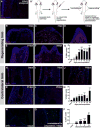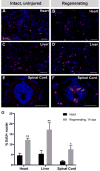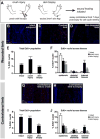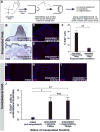Systemic cell cycle activation is induced following complex tissue injury in axolotl
- PMID: 29111100
- PMCID: PMC5750138
- DOI: 10.1016/j.ydbio.2017.07.010
Systemic cell cycle activation is induced following complex tissue injury in axolotl
Abstract
Activation of progenitor cells is crucial to promote tissue repair following injury in adult animals. In the context of successful limb regeneration following amputation, progenitor cells residing within the stump must re-enter the cell cycle to promote regrowth of the missing limb. We demonstrate that in axolotls, amputation is sufficient to induce cell-cycle activation in both the amputated limb and the intact, uninjured contralateral limb. Activated cells were found throughout all major tissue populations of the intact contralateral limb, with internal cellular populations (bone and soft tissue) the most affected. Further, activated cells were additionally found within the heart, liver, and spinal cord, suggesting that amputation induces a common global activation signal throughout the body. Among two other injury models, limb crush and skin excisional wound, only limb crush injuries were capable of inducing cellular responses in contralateral uninjured limbs but did not achieve activation levels seen following limb loss. We found this systemic activation response to injury is independent of formation of a wound epidermis over the amputation plane, suggesting that injury-induced signals alone can promote cellular activation. In mammals, mTOR signaling has been shown to promote activation of quiescent cells following injury, and we confirmed a subset of activated contralateral cells is positive for mTOR signaling within axolotl limbs. These findings suggest that conservation of an early systemic response to injury exists between mammals and axolotls, and propose that a distinguishing feature in species capable of full regeneration is converting this initial activation into sustained and productive growth at the site of regeneration.
Keywords: Axolotl; Cell cycle; Limb regeneration; MTOR; Systemic.
Copyright © 2017 Elsevier Inc. All rights reserved.
Figures






References
-
- Foex BA. Systemic responses to trauma. Br Med Bull. 1999;55(4):726–43. - PubMed
-
- Cordeiro JV, Jacinto A. The role of transcription-independent damage signals in the initiation of epithelial wound healing. Nat Rev Mol Cell Biol. 2013;14(4):249–62. - PubMed
-
- Anthony DC, Couch Y. The systemic response to CNS injury. Exp Neurol. 2014;258:105–11. - PubMed
Publication types
MeSH terms
Substances
Grants and funding
LinkOut - more resources
Full Text Sources
Other Literature Sources
Miscellaneous

